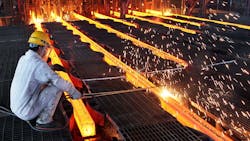What Happens When China's Steel Curbs End? Here’s One Company’s Take
Steelmakers in China are about to get back to business full-time. When unprecedented winter supply curbs lapse in the coming weeks, BHP Billiton Ltd. forecasts mills in the top producer will step up output, boosting run rates through the second quarter to make up for curtailments.
The resumption will be gradual as provinces step back from curbs designed to fight air pollution, according to Chief Commercial Officer Arnoud Balhuizen, who presented the outlook from the world’s largest miner for commodities including iron ore and steel. At present, the restrictions are set to ease from mid-March.
“Our base case is that the winter restrictions expire in staggered fashion across localities, with the blast furnace fleet expected to return to the high utilization rates that prevailed prior to the winter curtailments sometime in the June quarter,” Balhuizen said in online comments that accompanied earnings this week. “This is required due to the gap in construction steel supply left by the permanent closure of induction furnaces.”
Miners and investors are tracking China’s efforts to rein in steel overcapacity by closing some plants, and at the same time tackle smog by ordering winter supply cuts. The two-pronged campaign has supported product prices, and stoked demand for higher-grade iron ore, benefiting miners including BHP, Rio Tinto Group and Vale SA. While BHP expects higher-grade ore to remain sought after, average prices may drop, according to Balhuizen, who said China’s demand growth may fall this year given a slowdown in housing and autos.
“While it will be challenging to maintain the same average prices as those achieved in the half year just concluded, we are optimistic that the 62% index price can be relatively resilient,” Balhuizen said. That’s the benchmark grade of the commodity, which has seen prices for 58% content fall, while the more efficient 65% grade has been in demand.
The impact of China’s winter campaign has been evident in recent production statistics. Mills in China produced less crude steel in November and December than in the same months in 2016. Asia’s top economy is by far the biggest player in the global market, accounting for half of worldwide supply.
“We estimate that 80% is the long-run equilibrium crude-steel capacity rate, consistent with the stated objectives in the industry Five-Year Plan,” Balhuizen said, referring to the nation’s 2016-2020 road map. “That compares to slightly less than 70% at the cycle trough and upward of 85% at the height of disruptions.”
Spot ore with 62% content was at $78.43 a dry ton on Wednesday, after averaging $68.39 in the second half of last year, according to Metal Bulletin Ltd. The discount on 58% content ore has widened to more than 40% from less than 15% in 2016. As mainland markets reopened on Thursday after a week-long break, iron ore futures in Dalian fell 0.6 percent.
Steel prices are expected to keep rising even after China lifts the winter output restrictions on production next month, Japan’s Tokyo Steel Manufacturing Co. forecast earlier this week. The outlook from Managing Director Kiyoshi Imamura cited strong local demand for infrastructure and manufacturing.
By Jasmine Ng
About the Author
Bloomberg
Licensed content from Bloomberg, copyright 2016.
